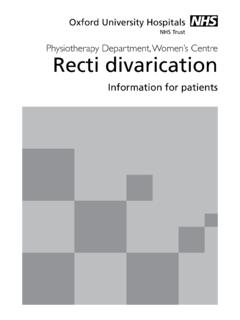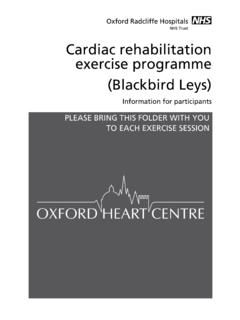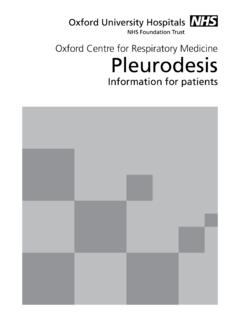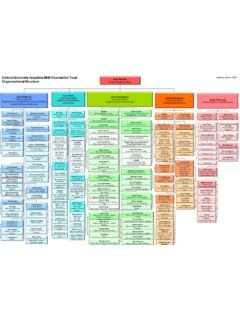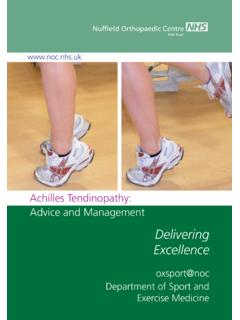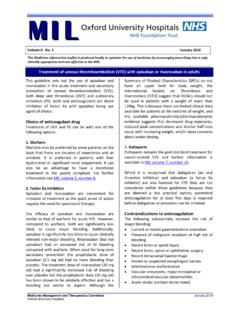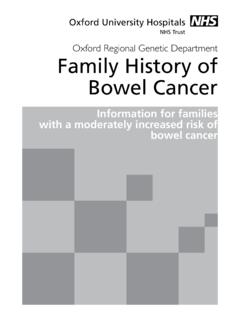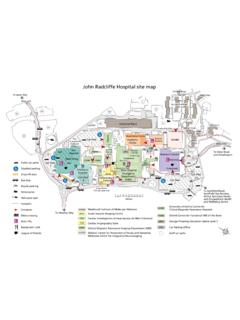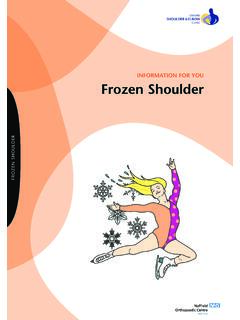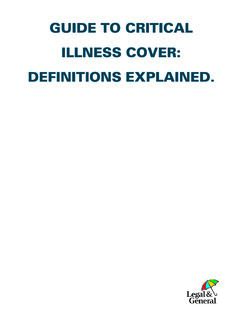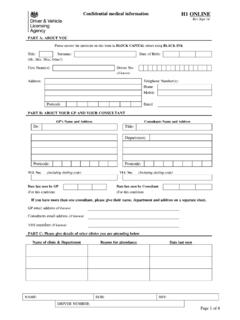Transcription of Implantation of a Cardiac Resynchronisation Therapy ...
1 Implantation of a Cardiac Resynchronisation Therapy - defibrillator (CRT-D). Consent information for patients page 2. Your doctor has recommended that you are fitted with a Cardiac Resynchronisation Therapy - defibrillator (CRT-D). A CRT-D is a small, metal, battery-powered device. CRT devices are used to help treat heart failure (when the heart does not pump as well as it should) by acting as a pacemaker and stimulating the heart chambers to pump at the same time. The defibrillator function sends impulses (fast pacing) to your heart muscle when your heart beats too quickly (which can cause life-threatening heart rhythms). These life-threatening heart rhythms are called ventricular tachycardia (VT) and ventricular fibrillation (VF).
2 If your heart continues to beat too quickly, it will then give shock treatment to your heart. The procedure is usually carried out using local anaesthetic (to make your skin and the area below go numb), pain relief and sedation (to make you feel drowsy). Depending on your medical history, your cardiologist may recommend that you are given a general anaesthetic (where you will be completely asleep). Your cardiologist will discuss which of these is the most suitable for you to have. page 3. How do I prepare for the procedure We will let you know before you come for the procedure (usually by letter), whether there are any specific instructions you need to follow.
3 The letter will include important directions for stopping eating and drinking. Please make sure you have a shower, bath or wash before you come into hospital/on the ward before your procedure. This helps to make sure your skin is clean and reduces the risk of infection. What happens before the procedure? The doctor (or nurse) will explain the procedure to you, including the risks and benefits. You will then be asked to sign a consent form to confirm you are happy for the procedure to go ahead. You will need to change into a hospital gown for the procedure. You may be able to keep your underwear on as long as it contains no metal (such as sequins or poppers).
4 Before the procedure, a small plastic tube (called a cannula) will be inserted in your arm, so that we can give you antibiotics (to reduce the risk of infection), pain relief and sedation during the procedure. The sedation will make you feel relaxed and sleepy but you will not be fully asleep. If you have any concerns, please do not hesitate to ask, as we would like you to be as relaxed as possible about the procedure. We will be happy to answer any queries you may have. page 4. What happens during the procedure? You will be asked to lie on your back on a narrow, firm table, which is positioned under an X-ray camera. This is used to help guide the doctor during the Implantation .
5 It is important that you lie still during the procedure, so that the pictures produced by the X-ray are not blurred. If you feel that you need to move or scratch an itch, please let the staff know. We will connect you to monitoring equipment to check on your heart rate, blood pressure and the level of oxygen in your blood. A specialist nurse or an anaesthetist will give you the sedation medicine or general anaesthetic and will watch over you very closely. We will clean your skin with an antiseptic solution, which may feel cold and wet, and your chest will be covered in sterile drapes. This helps us to keep the wound as clean as possible.
6 You will be given a local anaesthetic, which will be given as an injection under your skin and below your collar bone on the side where your CRT-D will be placed. This may sting at first, but will soon go numb. The CRT-D will be implanted under your skin in a pocket that the cardiologist will make in front of the muscle on the left or right of your upper chest (usually on the left). Occasionally it is implanted under the muscle layer. As with any surgical procedure, there will be a visible scar, and there may be a small bump where the CRT-D is placed. The CRT-D will then be connected to your heart using two or three flexible leads that pass through a vein under your collar bone.
7 The cardiologist will insert the leads into your heart using X-ray images to guide them. Moving the leads inside your heart is completely painless. During the procedure we may need to test the shock function of the CRT-D. This will depend on your medical history. At this point page 5. you will be given more sedation and we will bring on' a life- threatening heart rhythm (VF) under controlled circumstances. The CRT-D will be programmed to treat the heart rhythm with shock Therapy . When the CRT-D has been implanted (and tested if needed) the wound will be closed using a single long stitch in the skin, rather than lots of small stitches.
8 This may be a non-dissolvable stitch, which will need to be removed by the Practice Nurse at your GP's surgery, or may be a dissolvable stitch, which will disappear over the next few weeks. You will be told which stitch you have and what you need to do before you are discharged. The wound will be covered by a dressing. Please keep it covered for seven days. During this time, try to avoid getting the dressing very wet. You will need to have a wash, rather than a shower or bath. After seven days you can remove the dressing and bath and shower as normal. If at any point you have any concerns about your wound, please see your practice nurse or GP.
9 The procedure time varies, but can take around two to three hours. page 6. Benefits The main benefit of CRT is that it makes your heart chambers pump synchronously (at the same time). You may feel less breathless and have more energy. The main benefit of the defibrillator function is that it works to protect you from the risk of sudden Cardiac death due to dangerously fast heart rhythms (VT or VF). The defibrillator can also treat some rhythm disturbances without you being aware of it by fast pacing, and without shocks. Risks All medical procedures have a risk of complications. There are some risks associated with Implantation of a CRT-D that are important to know about.
10 There is a 1% (1 in 100) risk of developing a collapsed lung (pneumothorax) as a result of a lead perforating (making a hole in) the lung. This often requires no treatment, but you may need a tube called a chest drain to be inserted to help reinflate your lung. There is a 1% (1 in 100) risk of developing a collection of blood around your heart ( Cardiac tamponade), as a result of a small hole being made to the inner lining of your heart during the procedure. This often requires no treatment, but you may need to have a small drain inserted to drain away the blood. There is a 3-4% (3-4 in 100) risk of one of the leads becoming dislodged.
